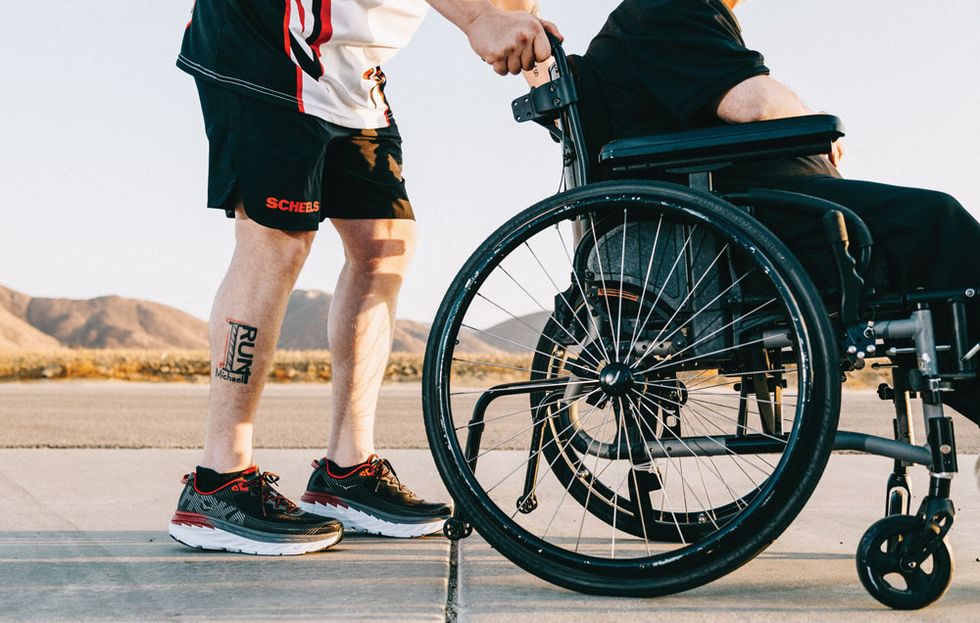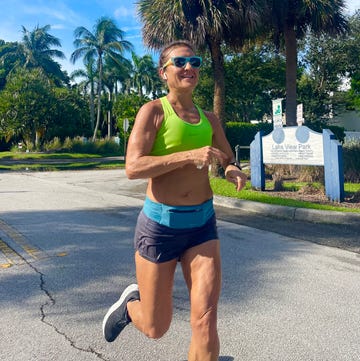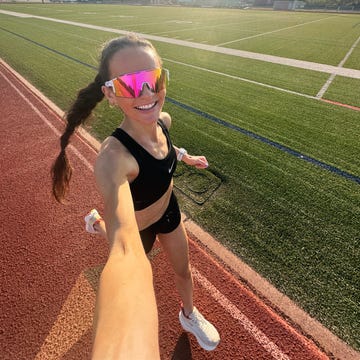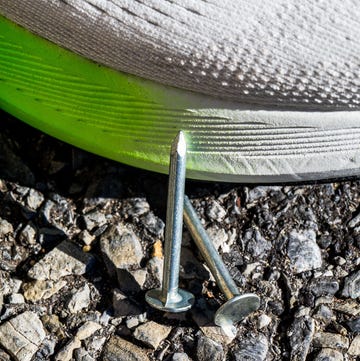Tim Boyle ran for many things when he first started in September 2012.
First, there was the girl. They had recently broken up. She was a runner, and though, while they were dating he never quite understood why she’d lace up her shoes and go outside into the frigid northern Minnesota mornings, he decided that proving to her that he could run a half marathon might take the sting out of their ended relationship. He gave himself six months to train for a race that she had already signed up for, hoping he’d bump into her at the finish line to show her that, yes, he could run, too.
Also, there were his lungs. They’d been abused for 17 years from a two-and-a-half-pack-a-day smoking habit that started after he graduated high school. He couldn’t sit through an entire movie without lighting up. His first pack was nearly done by 5 a.m., when he arrived at a dairy distribution plant to start his job delivering milk.
“I was tired of having tobacco consume every aspect of my life,” Boyle says. So he quit, on August 7, 2012. The next month, he took the $310 he normally used for cigarettes and went to a running store to buy shoes and clothes.
He ran for fresh-cut grass. He could smell it on his first three-miler near his home in Crookston, Minnesota, an 8,000-person town just east of the North Dakota border. In the middle of the loop, while crossing a bypass, he remembers seeing mowers trimming the lawn. He breathed deeply. “It’s one of my favorite smells,” he says. “That’s when I fell in love with running.”
And he started running for his mental health. He was diagnosed with depression in 2007 after attempting suicide. He swallowed nearly 30 Flexeril pills and 21 Oxycontin. He called the ambulance himself, but not to save his life. “I was worried that what I had taken wasn’t enough,” he says. “I wanted to get my stomach pumped so I could put a gun to my head.”
Instead, doctors convinced him to go to therapy. Five years later, he hoped running could help him cope with the demons that sometimes still surfaced.
There are a thousand little things we choose to run for: the smell of a freshcut lawn, to prove an ex wrong, to earn a medal. And a thousand more big things: to fight an addiction, to lose weight, to cope with depression. Find the right combo of motivators, and running becomes a habit, a necessity. It can change your life.
RELATED: Discover how to be a fit, healthy runner with Train Smart, Run Forever
But then it starts to snow and the weather dips below freezing. Nobody is mowing their lawn and your knees ache. All you really want, desperately, is a smoke and some fried food. None of the things in your life, big or small, can convince you to get out the door.
In November 2012, Tim Boyle ran out of things to run for. Desperate for motivation, he started googling inspirational quotes. He found a dark gray image with a silhouette of a tree behind a poem in white letters. It read: “I run because I can. When I get tired, I remember those who can’t run, what they would give to have this simple gift I take for granted and I run harder for them. I know they would do the same for me.”
Boyle reposted the photo to his Facebook profile. The first person to comment was a man named Michael Wasserman, who wrote, “You can run for me anytime.”
Mary Wasserman will never forget the day she visited a state mental institution as a high school volunteer in the late 1950s. She remembers the noxious smells, the sights and sounds of suffering. More than half a century later, she finds the scene difficult to describe. “It was one of the most horrible things I’ve ever seen,” she says.
Mary gave birth to a boy, Michael Wasserman, on November 7, 1961. Back then, there were no tests to determine if your baby had Down syndrome in the womb, and Michael was diagnosed after he was born. He weighed just four pounds and had hazel eyes.
“He was just beautiful,” Mary says.
Which is why, when doctors recommended that she give Michael up to institutional state care, she refused. Despite knowing Michael would need a lifetime of support, she was not going to send her son away. She brought him home on Christmas Eve day.
Despite his challenges with verbal communication, Michael grew up smiling—a grin that seemed to consume his face. He smiled when he got a glass of water or when he met new people or when he danced, which was often.
Seven years after he was born, Eunice Shriver Kennedy founded the Special Olympics. Michael signed up, competing in the softball throw and swimming. And yes, he ran. The 50- and 100-yard dashes. He made friends with everyone he met, graduated from a special-education school, and reminded Mary daily precisely why she’d brought him home.
His smile didn’t fade, but Michael slowed down in 1983. He told his mother he could no longer walk. After visiting a bevy of specialists, he was diagnosed with bilateral bone-on-bone hip dysplasia—a debilitating condition that painfully forces the hip joints out of alignment.
To treat it, doctors had to experiment. The surgery Michael needed was completely new. They rebroke his bones in several places, rebuilding the joints so he could walk again. Which he did, in 1986. His recovery is literally a textbook case. Surgeons around the world still consult his procedure when studying the condition.
But he wasn’t just able to walk. After surgeries and 17 months of daily physical therapy, he could dance and run again. He competed in the 50-yard dash at the Special Olympics in 1987 and won a medal. He attended an orthopedic conference, where, in front of hundreds of surgeons, he ascended and descended 28 steep steps in the amphitheater. He received a standing ovation.
“I still have trouble getting through that story without tears,” Mary says.
He was mobile for 24 years and 24 days. But in 2009, he sat down and once again told his mother he could no longer walk. He was living with Mary and her husband, Albert, in Aptos, California. This time, surgery was not an option.
Three years later, Michael and Mary browsed through the Facebook page they had made to share his story and auction his art for charity—Michael’s latest passion. The bright, abstract canvases often sell for more than $100.
It’s there that they stumbled on a post from a man who was looking for some motivation to run. Mary helped Michael type the message.
“You can run for me anytime.”
Man, that’s brilliant, that is exactly what I will do, Boyle thought. He reached out to Michael and Mary through a Facebook message.
“I want to be your legs,” Boyle wrote. “I am going to dedicate all of my training miles and my next race to you.”
Mary seemed wary at first. The special needs community is very tight-knit, and she is cautious when people who don’t directly know Michael want to get involved with his life. Plus, she didn’t exactly know what this all meant—dedicating miles to her son.
“It means, when I get tired and want to quit, I think about him in his wheelchair and the fact that he is not able to get up and run,” Boyle says. “It is no longer about me.”
Michael’s challenges put Boyle’s pain in perspective. It wasn’t the smell of fresh-cut grass or fighting his nicotine addiction or even coping with depression that got him to the finish line of his very first race—a 5K in February 2013—it was completing the miles for Michael.
The whole concept appears, at first, to be tenuous—exploitative even. This is, after all, a man with perfectly functioning legs using a stranger with Down syndrome, who lives more than 1,800 miles away, as a sort of totem to achieve his own personal goals.
But Boyle and Mary insist this is not the case. Boyle sent weekly, if not daily, updates about his training to Michael (Mary would help Michael read and respond to the messages). Michael would send Boyle updates about his pain management and painting. They became fast friends, albeit very long-distance ones.
Boyle shipped Michael the finisher’s medal from his first 5K. He’s sent most of his race medals to Michael since.
During several low points in Boyle’s life, when the depression creeps back to the fringes of his brain, he has turned to Facebook to cope. After the diagnosis in 2007, he discovered a Facebook page about Down syndrome. Seeing the stories from thousands of people with the condition put his own life in perspective. Their sheer, unbridled joy over the smallest things boosted Boyle’s own mood.
After the experience of completing a race for—and then building a relationship with—someone who couldn’t run, Boyle realized a few other people might want to do the same. So he once again turned to Facebook. With Mary’s permission, he created the page “I Run for Michael.”
He invited fellow runners to join the group, and Mary helped him invite people from the special needs community. Boyle formed a nonprofit with the same name as the Facebook group, but they did not want the attention to focus only on Michael. They decided to match each runner with a different person with special needs.
Runners posted updates to their “buddy,” filling them in on their training. Buddies posted back, updating their runners on surgeries and life accomplishments.
More than 500 people joined in the first month, and more than 15,000 in the first year.
“This group could be 40 people or it could be 40,000 people, Michael doesn’t care,” his mother says. “What he cares about is that people are motivated, encouraged, and happy.”
And that is exactly the point of the group, Boyle says: Bring strangers together who would have never met otherwise, to motivate and encourage each other, whether they are training for a marathon, undergoing surgery, finishing an Ironman, or learning how to use a wheelchair.
In less than five years, the I Run for Michael organization has matched more than 20,000 runners with 20,000 buddies—most of them children, all of them with a disability that prohibits them from running or, often, even walking.
Scrolling through the Facebook page is therapeutic—an instant mood booster. Your grin can’t help but grow with every new post. They are all displayed to the main feed in the group, so every member can read them. The posts are personal. Genuine. It’s like having access to the letters from 40,000 pen pals.
Boyle is a strict moderator. He bans people if they discuss politics or post anything hateful. And he does not allow links. Though many runners have created fundraisers for a charity that helps their buddy, Boyle does not want the group to be inundated with posts asking for money. He wants them to be uplifting and motivating. There are a lot of exclamation points.
“Hi Avery! I had a killer headache today, but I was still able to get our workout done. How was speech on Tuesday? I hope you did well?”
“Hi Daniel! The baby and I ran 3 miles for you this morning. How has your week been? Mine’s been crazy hectic, as always!”
“Hey Gavin! I just saw your mom posted about you getting a swing! That’s awesome buddy… even at my age I enjoy a good swing! We got 12 miles in this morning!”
Most of the buddies are children, so their parents respond—posting pictures of a medal they just received from their runner, updating the group on a doctor’s visit, or sharing photos of a new life milestone.
“When you have a child with disabilities, your world is isolated,” says group member Sue Allen. Her 6-year-old son, River, has spina bifida and uses a wheelchair. “You are constantly going to the doctor.”
Allen, like Mary Wasserman, was initially skeptical of the concept behind I Run for Michael. But she signed up River after seeing the encouraging posts. Her son matched with a Tampa-based runner named Jodi Stoner in 2014.
“I love it because you make this connection where you give and they give, and it is just a beautiful thing,” Allen says. The community, she says, has expanded her and her son’s world outside of just the context of special needs.
Stoner has visited River multiple times, pushing him in a specialized wheelchair during races. Boyle says that’s common. He intentionally makes matches random, and does not allow requests, because he wants strangers to develop a relationship and learn about each other without previous knowledge. But, he says, many of the pairings take their newfound digital friendship off Facebook through in-person visits, attending races together, and sending each other birthday gifts or finisher’s medals. A few runners have gotten tattoos of their buddy’s name.
RELATED: 47 Awesome Running-Inspired Tattoos
“This is so much more than running: It’s mental, it’s emotional, it’s an attachment,” Boyle says. “Running is just a catalyst to form a relationship.”
He and Michael keep in touch about once a week. They’ve met in person twice.
“I can’t begin to quantify or even qualify what this has done for me,” Boyle says. Five years ago, he was desperate to find something to run for. Fresh-cut grass wasn’t doing it. Neither was his desire to get healthier.
Instead, he ended up finding someone to run for. And that might be the paradox in the whole idea, Mary says. Michael didn’t need someone to run for him. Instead, he wanted to encourage someone, motivate them. Make their life happier.
He’s ended up doing just that—for Boyle and for more than 40,000 others.
In Michael’s bedroom, on a wall near his bathroom, he’s posted a photo of Boyle after a race. Mary says that each time he passes it, he touches Boyle’s face. She’s seen him do it multiple times. He smiles. “Buddy,” he says.
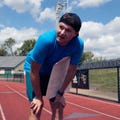
Kit has been a health, fitness, and running journalist for the past five years. His work has taken him across the country, from Hayward Field in Eugene, Oregon, to cover the 2016 Olympic Trials to the top of Mt. Katahdin in Maine to cover Scott Jurek’s record-breaking Appalachian Trail thru-hike in 2015.

